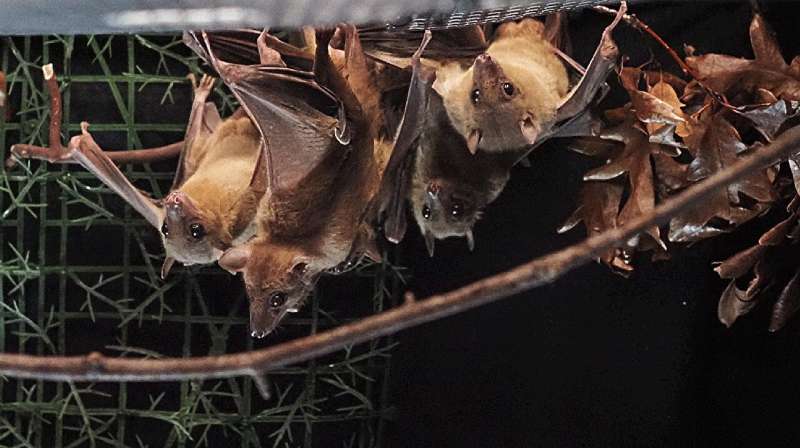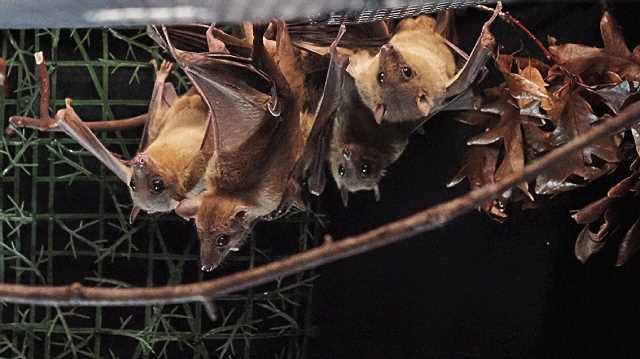
The same neurons that help bats navigate through space may also help them navigate collective social environments, finds a new study published today in the journal Nature.
Many mammals—including bats and humans—are believed to navigate with the help of a brain structure called the hippocampus, which encodes a mental “map” of familiar surroundings. For example, as you walk around your neighborhood or commute to work, individual “place” neurons in the hippocampus fire to indicate where you are.
In the new study, researchers at the University of California, Berkeley, used wireless neural recording and imaging devices to “listen in” on the hippocampal brain activity of groups of Egyptian fruit bats as they flew freely within a large flight room—often moving among tightly clustered social groups—while tracking technology recorded the bats’ movements.
The researchers were surprised to find that, in this social setting, the bat’s place neurons encoded far more information than simply the animal’s location. As a bat flew toward a landing spot, the firing of place neurons also contained information about the presence or absence of another bat at that spot. And when another bat was present, the activity of these neurons indicated the identity of the bat they were flying toward.
“This is one of the first papers to show identity representation in a non-primate brain,” said study senior author Michael Yartsev, an associate professor of bioengineering and neuroscience at UC Berkeley. “And surprisingly, we found it in the hub of what was supposed to be the brain’s GPS. We found that it still acts as a GPS, but one that is also tuned to the social dynamic in the environment.”
While not as visually stunning as a school of fish or a murmuration of birds, highly social animals like humans and bats also exhibit forms of collective behavior, said study first author Angelo Forli, a postdoctoral fellow in Yartsev’s NeuroBat lab.
“Social animals, like humans, will coordinate in space to achieve different goals,” Forli said. “It might be just visiting others. It might be moving together, as in the case of classical collective behaviors or playing a soccer match. Or it might be other forms of cooperation or conflict.”
Due to the complexity of the experiment, Forli initially had doubts about whether allowing groups of bats to fly and interact freely would yield results about the neural basis of collective behavior. He was concerned that the movements of the bats and their social interactions might be too random to uncover robust relationships between their neural activity and their behavior.
So he was pleasantly surprised when the bats spontaneously established a handful of specific resting spots within the flight room and followed very similar trajectories when traveling among them. The bats also showed strong preferences for flying toward specific “friend” bats, often landing very close to or even on top of each other.
“We found that if you put together a small group of bats in a room, they would not actually behave randomly, but would show precise patterns of behavior,” Forli said. “They would spend time with specific individuals and show specific and stable places where they liked to go.”
These precise patterns of behavior allowed Forli to identify not only the neural activity associated with different flight trajectories, but also how the neural activity changed depending on the identity of the bat present at the target location and the movements of other bats.
“By recording just a handful of those neurons from this brain structure, we can really know what the bats were doing in their social space,” Yartsev said. “We could find out if they were going to an empty location or to a location where there were other individuals, which is really surprising.”
In recent years, Yartsev and his NeuroBat Lab have used a variety of wireless neural recording devices and flight tracking technologies to uncover a number of surprising details about the brain, including how bats’ neural activity syncs up while they socialize; how activity in the frontal cortex helps bats identify self vs. others during vocal interactions; how bats’ hippocampus maps not only specific locations, but full flight trajectories; and even how stable spatial memories might be stored in the brain.
This new study brings together the team’s work on navigation and social behavior, showing how these two things are fundamentally intertwined within the brain. The findings also help illuminate why damage to the hippocampus in humans has been linked to both social and spatial aspects of memory loss in neurodegenerative diseases like Alzheimer’s.
“Our episodic memories are a combination of the environment where we are located and our experiences within it—including, of course, our social experiences,” Yartsev said. “Our results are surprising, in the sense that no one has observed this connection before in groups of animals and at the individual neuron level. But they also make sense in that they are very consistent with deficits that people with damage to the hippocampus experience.”
Finally, this study highlights a very important point, Yartsev said. While most of the neuroscientific community examines the brain under “simplified” or “artificial” conditions that are often far removed from the natural behavior the brain has evolved to promote, this work demonstrates the power of the natural approach to neuroscience research.
“For half a century, people have been studying place neurons, but 99% of that work has been done in single animals moving in an empty box,” Yartsev said. “Our findings suggest that there is a lot that can be learned when neuroscience research focuses on natural behavior.”
More information:
Michael Yartsev, Hippocampal Representation During Collective Spatial Behavior in Bats, Nature (2023). DOI: 10.1038/s41586-023-06478-7. www.nature.com/articles/s41586-023-06478-7
Journal information:
Nature
Source: Read Full Article
